Broom Delivers a Psyllid Surprise
Stripy broom psyllids have black striped forewings, while our usual broom psyllid has mostly clear wings. However, stripy broom psyllids can have weak wing markings, and adult body colour varies from black/brown to pale green. Likewise, the usual broom psyllid is normally pale brown, but can be pale green. Adult stripy broom psyllids are noticeably larger (3.5mm body) with wider heads, compared with the usual broom psyllids (3mm).

Stripy broom psyllid adult and nymph Inset: broom psyllid
In spring 2021 we started some detective work on Jon’s psyllid surprise. Our first question was simple: could we rediscover the stripy broom psyllid on broom near Christchurch? But first, the two broom psyllids need further introduction.
In the native range of broom in the UK these are the only two psyllid species commonly found attacking the plant. The species we call the broom psyllid was preferred for biocontrol of broom in New Zealand because it causes substantial stunting of broom plants and is host specific. The stripy broom psyllid is seldom found in sufficient numbers to damage broom in the UK, and can reproduce on other plant species that are closely related to broom, such as tagasaste (Chamaecytisus palmensis) and Genista spp.
During our spring 2021 surveys we easily rediscovered the stripy broom psyllid on broom close to where Jon had found it on sticky traps. Widening our search, we found the stripy broom psyllid was common over the Canterbury Plains and Banks Peninsula. If some of you readers further afield are interested in a bit of detective work, it would be great if you could check your local broom for a psyllid surprise. Just sharply tap broom over a beating tray and quickly check for psyllids. From about Christmas you can’t be confused by finding the deliberately released broom psyllid, because this species only has one very early season generation: from mid-summer to the next spring the minute, dormant, first instar nymphs remain hidden inside broom shoots. So in the latter part of the growing season any adult psyllids on broom, especially if they have dark wing patterns, and all psyllid nymphs, are highly likely to be the stripy broom psyllid. Please send the insects in preservative, or good close-up photos, to Simon Fowler.
Now, on to the next obvious question: how did the stripy broom psyllid get to New Zealand? One possibility we are keen to rule out is an escape from our quarantine facilities at Lincoln, near Christchurch. Almost 10,000 broom psyllids, including many nymphs, were imported from the UK into containment at Lincoln during the 1990s. The nymphs of the two broom psyllids are similar, so some stripy broom psyllids may have inadvertently been imported with the broom psyllid nymphs. However, strict rearing and identification protocols determined that only adults of the broom psyllid were released. In the extremely unlikely event of the stripy broom psyllid somehow getting out of containment and establishing a field population in the 1990s, we are very sure that it would have been discovered during the many field surveys carried out since the psyllid was held in containment. Two surveys in the last decade were particularly exhaustive. From 2012 to 2017 we searched for psyllids on broom at many sites across New Zealand as part of our studies on the plant pathogen, Candidatus Liberibacter europaeus (Leu). In this nationwide survey no stripy broom psyllids were identified, by either visual or molecular techniques. In addition, no stripy broom psyllids were found between 2014 and 2017 by Francesco Martoni, an enthusiastic Lincoln University PhD student, when creating his checklist of New Zealand psyllids.
We also can’t blame strong winds across the Tasman Sea for this psyllid invasion: the stripy broom psyllid is not known from Australia. We therefore think the most plausible explanation is that the stripy broom psyllid arrived as a stowaway on a boat or plane from either its native range in Europe, or its adventive range in the USA. Molecular investigation could sort out the source of our psyllids and reveal whether the stripy broom psyllid has acquired Leu in New Zealand, or brought its own Liberibacter spp. There are other unresolved questions relating to the host range and potential impact of the stripy broom psyllid on broom in New Zealand. So watch this space for part 2 of the story.
